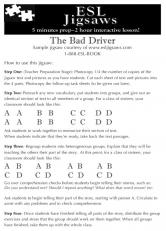ESL Jigsaws
5 Minutes Prep - 2 Hour Interactive Lesson!
A Fun Way to Teach Body Parts
Jigsaws aren’t the only cooperative learning activity that I do in my classroom. Here is a fun activity for reviewing body parts. I divide the class into groups of three and give each group a sheet of chart paper and a felt marker. I ask the students to take turns being the artist.
The students are instructed to write no English on the paper. All that should be on the paper are drawings. Students are instructed not to draw a whole person, but rather each body part separately as it is called out. I then call out 30 body parts. The first one is something easy like “nose” and then I move on to more challenging ones. It’s a great activity for shaking up the atmosphere. Students often get up out of their chairs and lean over the paper and offer opinions on how to draw each part. A lot of laughter is the inevitable outcome.
When the last body part has been drawn, I collect the felt markers and ask each group to take out one ballpoint pen. The chart paper is then passed to the neighbouring group, moving clockwise. This is the labelling stage of the activity. Each group is to label the body parts on the other groups’ paper, without the aid of dictionaries or reference to class handouts. Lots more laughter ensues as groups try to make out what the drawings are meant to be.
After a short interval, time is up and the groups must pass the chart paper to the next group to finish labelling any unlabelled parts. This is also the correction stage. Groups are to correct any spelling or labelling errors of the previous group. Another short interval and the paper is passed on again.
When groups finally get their own paper back, they check whether the other groups correctly labelled their body parts. Papers can then be hung on the walls.
They say that students need to see a new word 8 times in order to make it part of active vocabularly. There are many ways to review body parts vocabulary. This fun cooperative learning activity puts students in a receptive mode for learning, integrates listening, speaking, writing and reading and encourages them to focus on the accuracy of their spelling.
Post your comment
Comments
No one has commented on this page yet.
RSS feed for comments on this page | RSS feed for all comments


